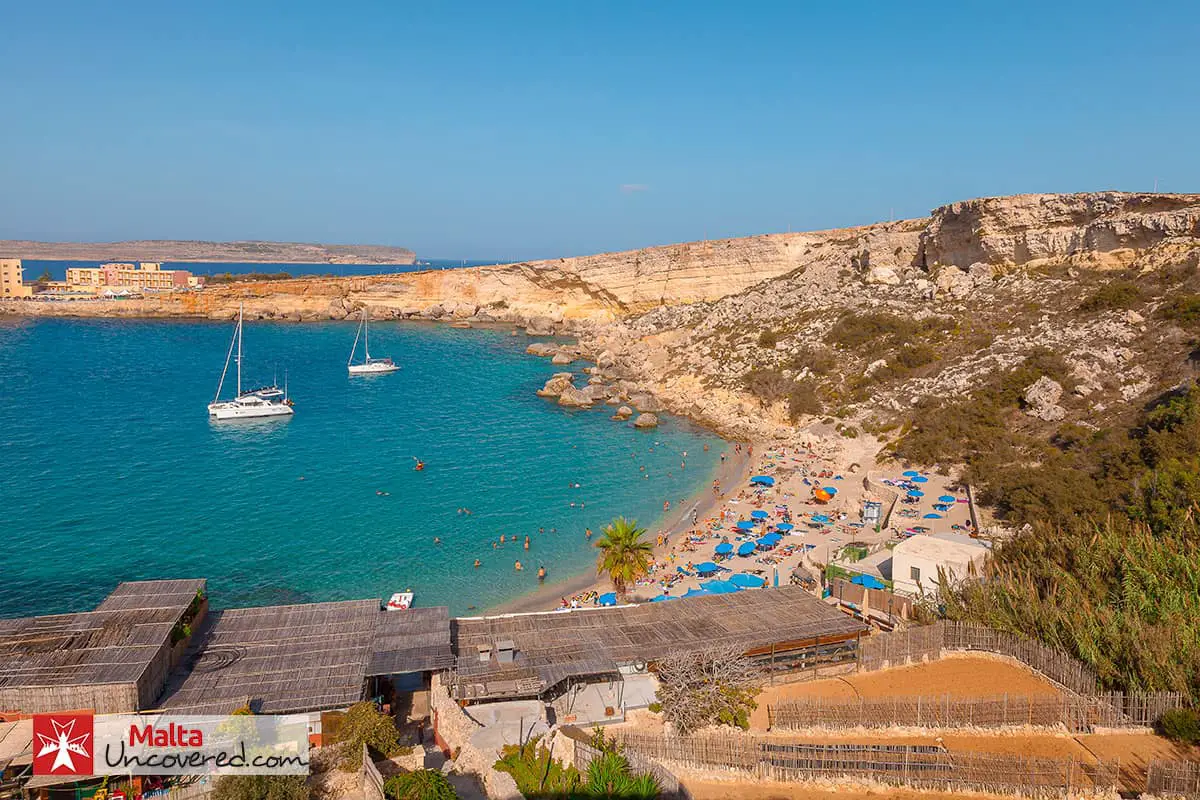Home » Malta island » The weather » Malta in July
Mostly known as a summer destination, the weather in Malta in July is one of the main reasons for this. The month is full of long, hot, sunny days with occasional heatwaves, followed by still evenings with little breezy respite.
While not a 100% guarantee, it’s extremely rare to have rainfall during July so you’ll be able to spend every day of your visit by the sea, the pool, or spending time outdoors without having to worry.
All that being said, July definitely falls within the peak tourist season in Malta, so expect places of culture and entertainment to be busy with visitors, beaches to be packed, and public transport to be working under some strain.
The weather in Malta in July is extremely hot, with warm temperatures feeling a little more stifling due to the high levels of humidity. Despite the ‘breathless’ and sticky feeling to the air, this is easily dealt with by making sure to keep well hydrated, walking and sitting in the shade whenever you can, and taking frequent respites in the air-conditioned indoors.
At this time, temperatures tend to range averages of 21-30o C (70-86o F), but be aware that the high levels of humidity can make the temperature feel much higher than it actually is, sometimes by several degrees! The evenings and nights in July can also feel rather sticky and stifling due to this same reason, especially when no cooling breeze picks up. Don’t let this discourage you though, as most places are well equipped with electric fans and air-conditioners.
Days in July are also pretty long as the average sunshine is around 12.2 hours daily. Furthermore, the chances of rainfall are very low at a 1.1mm average.
Best of all, seawater temperatures average around 25o C (76o F), meaning you don’t have to worry about bracing yourself for a cold swim, but instead you can easily dive into the refreshing waves.
Keep in mind that local authorities encourage people to stay out of direct sunlight between the hours of 10:00 and 16:00 as the rays can be particularly strong during this part of the day. Always keep well hydrated (more than you think is enough, trust me) and always slather on sunscreen frequently. Tanning is great but don’t forget to protect your skin, especially if you’re not used to this kind of sunshine.
Yes, Malta is definitely warm in July. It would probably be better to describe it as being hot. The sun starts beating down early on in the day, and even after sunset, the air remains very warm.
One thing that foreigners are always quite surprised to face is the high levels of humidity. Locals describe this simply as a heavy feeling in the air, making it feel stifling and extra hot. Don’t worry, you will get used to this phenomenon very quickly. The only real downside to this is that your hair will likely get more frizzy and temperatures will feel much warmer than they actually are.
UV rays are also very high at this time of year so remember to protect yourself with sunscreen, sunglasses, and a hat.
Yes, definitely. July is one of the sunniest months of the year in Malta, boasting very long days of strong sunshine. It’s highly unusual to get dull or grey weather in July, although the strength of the sun’s days will vary, especially from the start to the end of the month.
Strong winds are more likely, as Malta tends to be quite windy all year round. However, it’s unlikely that the wind will bring with it any bad weather. Don’t be surprised if the wind feels like it’s blowing about dust, as strong Southern winds blow Sahara desert sand to the islands, covering cars, streets, and even buildings in a coating of brown sand and dust.
Malta in July is the ultimate summer destination. The Maltese people have long since found ways to make the best of the heat and enjoy it to the full – beautiful bays surround the islands with the option to rent umbrellas and deckchairs, outdoor dining comes with fans and umbrellas around tables, and places selling cold drinks and ice-creams are pretty much on every corner.
If you don’t mind attending historical sites, museums, restaurants, beaches, and events that are somewhat overcrowded with people, then Malta in July is the perfect spot for you. The entire island is open for business and entertainment at this time, and many seasonal places (such as open-air clubs and bars) are in full swing in July. There is definitely lots to do and many places to go.
While the countryside is still open for everyone to visit and explore, I wouldn’t recommend doing this simply because the heat can get pretty unbearable pretty quickly, and the dry heat turns the previously lush landscape into a very dry and dusty, beige background. Luckily, you can replace the greens with the blues and enjoy discovering all the little beach spots that are hidden all around the island’s coast.
Talking to locals will quickly set you on the right path to finding the less popular (but no less beautiful) swimming spots and if you find an extremely friendly bunch, you might even find yourself being invited onto someone’s boat or to their evening barbecue. Maltese people are friendly and the possibility to sit outside and enjoy the day’s end with a cold beer and some barbecued food brings out the generosity in several.

Check out my two guidebooks full of local knowledge and my best recommendations for your trip, and up-to-date for 2024!
Malta & Gozo guide book
Valletta: An Insider’s Guide to Malta’s Capital
Take the hassle out of planning your trip to Malta and be an informed traveller!
July is the perfect time to make the most of the stunning Mediterranean sea that surrounds Malta, as well as the beautiful beaches and panoramas that you can take in. While Malta is indeed a summer destination, this doesn’t mean that swimming is the only thing you can do in Malta. History waits for you to discover it, as do hidden nooks and crannies all around.
That being said, do keep in mind the local authorities’ suggestion of avoiding the sun between 10:00 and 16:00. You might want to adjust your itinerary accordingly so you’ll make the most of indoor activities during this time.
If you’re considering going on sightseeing tours while you’re visiting, there are a couple that are well suited for this time of year:
TIP: Get 5% off using coupon code MALTA5
Looking for more? Check out my list of various events organised annually in Malta and Gozo.
Get my recommendations on the best day trips, boat trips, excursions and activities and book in advance!

The weather in Malta in July makes for the ultimate beach island holiday. Whether you prefer to relax against a sandy beach, or are happy to lounge on the rocks, the different bays around the Maltese coastline offer you a variety of options.
Hot sunshine and very low prospects of bad weather make for the best excuse to cool off in azure sea waters and slowly build up a tan. However, don’t think you’re the only one to have this idea. With schools being officially out, many Maltese families with young children and groups of teenagers alike will be filling up every square inch of the beach during the week. Tourists and other beach-goers will take up any of the remaining space, with several choosing to spend from sun-up to sun-down firmly in the same spot.
Don’t let this deter you. There’s many different options and beaches where you can go for a swim around Malta (it is, after all, an island surrounded by sea). If you really don’t want to be around large crowds of people, secluded and hidden beaches can easily be found with a quick online search and a question or two for directions to a friendly local.
On the other hand, if you don’t mind sharing the bay with others, you won’t regret giving the more popular beaches a go. There’s a reason why they are so well-loved and this is because a lot of them offer absolutely stunning views and beautiful blue waters.
Have a look at my list of Top 10 beaches as it will help you make up your mind what kind of beach day experience you wish to have. If you’re visiting for a few consecutive days, you might like to carry out your own experiment and give different Maltese beaches a go and draw your own conclusion as to what you prefer.
Malta in July is the perfect setting to having fun adventures and discovering new places and histories, and luckily, the almost-guaranteed sunny weather allows you to do just this. Here are some more ideas of things you can do during your visit:
Looking for inspiration on how to plan your trip to Malta? Consult my tried-and-tested Malta itineraries:
Yes, July is a great time to visit Malta if you are looking for lots of sun, sea, and sand (or rocky beaches, the island offers several of both). Aquatic activities like wind sailing, snorkelling, diving, and fun water rides will keep you and your young ones entertained, punctuating the relaxing breaks of lounging on deckchairs and enjoying great food in the sunshine.
Do, however, be aware that the heat can be very strong and sometimes unbearable, especially for those not used to it. If you’re worried about this, avoiding the summer months altogether might be a good idea and aiming for months with a more gentle temperature, such as March, April, May, or June.
Apart from this, you can always spend time shopping at the summer sales, learning more about Malta’s history at the various museums and historical sites, and sampling all the divine local food and drinks. Various musical, cultural, and other entertaining events are constantly being held as summer is truly when the country is alive and buzzing.
Fortunately, while you do all this you don’t have to worry about bad weather ruining your plans.
July is at the peak of the two most busy tourist months in Malta which means that most places of accommodation will fill up pretty quickly and also come at a more expensive price. However, with some good research and planning ahead, you might be lucky enough to find a good deal that makes every cent you spend well worth it.
If you’re looking to have a restful holiday in a hotel, you can find several good options with luxurious extras like pools and activity areas for children. You can also opt to go for a less luxurious option but which covers all the basics if you’re planning to spend most of your time away from the accommodation. Most importantly, make sure that wherever you stay has an air-condition or multiple fans. The summer heat can be quite unbearable even during the nighttime.
Otherwise, you can look into self-catering options like apartments and AirBnBs which give you more freedom in coming and going any time you please. If you still wish to have some luxury on your holiday, you can look for farmhouses or villas with pools and large outdoor areas. Bed and Breakfasts are also an alternative if you wish to find a happy medium between a hotel and a self-catering place of accommodation.
The more important factor to consider when choosing where to stay in Malta is location. While the island is small, getting around, especially in the busy summer months, can be a bit tedious and stressful if you’re not prepared. For the sake of ease and efficiency, it’s best to settle in a spot that is close to where you plan on spending your time in Malta.
Valletta is good to stay in as it’s the home of the main bus terminus with buses leading to every part of the island. However, the popular sandy beaches are quite a long bus ride away in the North of the island, so you might not want to be staying so far. For what it’s worth, the capital does host several shops, bars, restaurants, and places of interest.
If on the other hand you’d rather be close to the upper-scale dining venues, nightclubs, and popular tourist areas, I would suggest staying somewhere like Sliema, St Julian’s, Buġibba, Swieqi, Gżira, Msida, or Ta’ Xbiex. Do make a note that these places tend to be the more expensive areas exactly for the reason that you want to stay in them.
Alternatively, if you want to spend your holiday by the beach, close to quiet local restaurants and promenades, areas like Marsascala, Marsaxlokk, Xgħajra, and Birżebbuġa in the South are ideal and all seaside. Mellieħa, Xemxija, Qawra, and St Paul’s Bay are similar but found North-side.
Mellieħa, in particular, is probably the best place you can be if you want to be close to many different beaches and summery spots. Do take note though, that if you want to spend at least some time exploring the rest of the island and sightseeing, staying here would require you to spend a good portion of your time travelling.
Gozo is always a great option if you truly want to get away from the humdrum of busy areas and simply want to make the best of a more rural location.
Read more here: Where to Stay in Malta
Leave a comment below and I’ll get back to you with an answer shortly!

Edward is the Founder and Editor of Malta Uncovered and author of two guidebooks on Malta and Valletta.
As a tourist-turned-expat with Maltese roots, he knows the islands inside out and helps thousands of visitors enjoy a memorable trip every year.
Get the best travel tips from Malta Uncovered delivered to you in bite-sized chunks by email. (Unsubscribe at any time!)
Was this article helpful? Share it with your friends!
Get the most out of your visit to Malta with Malta Uncovered guidebooks – full of local knowledge and up-to-date for 2024!
